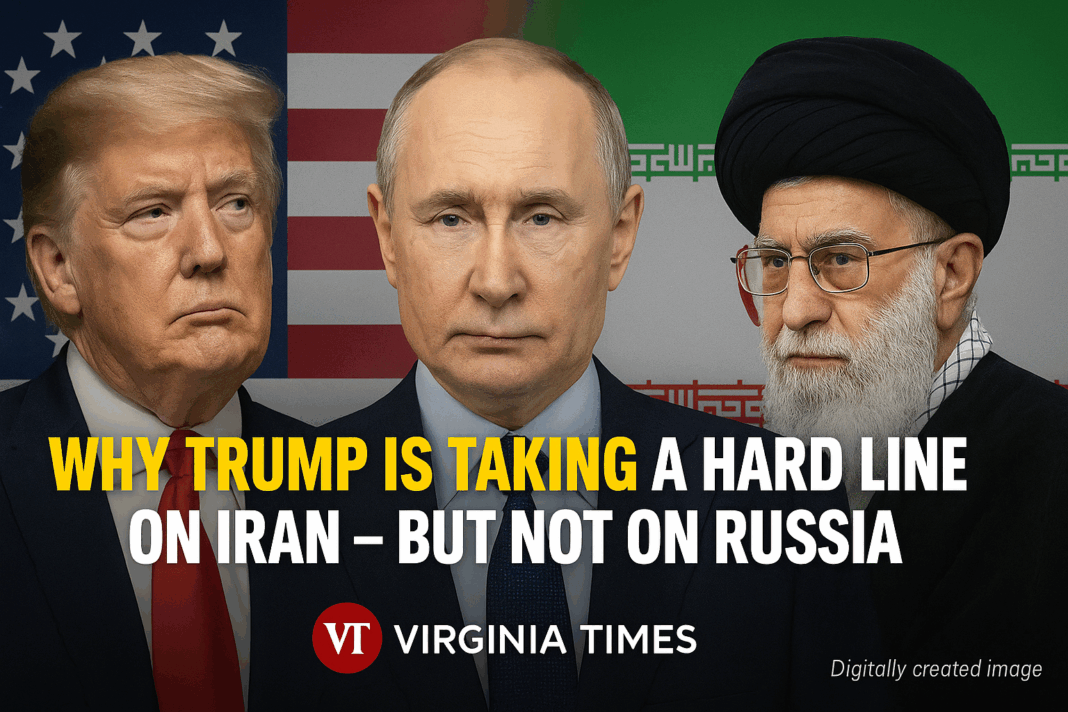- Trump has demanded Iran’s “unconditional surrender” in a series of Truth Social posts.
- He has not made similar threats toward Russia, despite the ongoing Ukraine war.
- At the G7, Trump defended Russia’s prior inclusion in the G7 but condemned Iran.
- Reports indicate a reduction in U.S. interagency pressure efforts on Russia.
- The approach reflects Trump’s pattern of confronting short-term threats while preserving long-term negotiating channels.
Trump’s Hardline Strategy on Iran
President Donald Trump has recently reasserted a firm and uncompromising stance on Iran, publishing a series of statements on Truth Social that signal a reactivation of his signature “peace through strength” doctrine. In these posts, Trump stated that the U.S. “knows exactly where the so-called ‘Supreme Leader’ is hiding,” referring to Ayatollah Ali Khamenei as “an easy target,” while clarifying that he would not “take him out (kill!)” — at least for now.
More notably, Trump called for Iran’s “unconditional surrender”, portraying the regime as a persistent threat to global stability and a violator of international norms. His comments reflect a broader strategic messaging campaign aimed at deterring nuclear escalation and curbing Tehran’s influence across the Middle East.
Supporters of Trump’s approach argue that such messaging is consistent with his broader foreign policy legacy—prioritizing U.S. security, standing firm against adversaries, and applying maximum pressure to bring hostile regimes to the negotiating table. Under his administration, the U.S. previously withdrew from the 2015 Iran nuclear deal and reimposed sweeping sanctions, which many credit with weakening Iran’s economic reach and reducing funding for proxy militias in the region.
While critics have warned of escalation, Trump’s allies maintain that credible threats, backed by American power, can serve as a stabilizing force. His current posture appears designed to reestablish deterrence and revive negotiations from a position of strength.
The tone reflects a potential return to the “maximum pressure” strategy Trump favored during his first term, now with heightened threats of military consequences.A Notably Different Approach Toward Russia
By contrast, Trump’s recent posture toward Russia has been significantly more measured. While Russia continues its war in Ukraine, Trump has not issued similarly confrontational statements.
At the June 2025 G7 Summit, Trump criticized Iran’s actions but suggested Russia should be reconsidered for re-entry into the former G8, saying its exclusion had been a “mistake” .
Speaking to reporters at the summit, Trump added that it was a “very big mistake” to remove Russia in 2014 after it annexed Crimea, a move that precipitated Russia’s wider invasion of Ukraine in 2022.
Additionally, Reuters reported that an interagency group coordinating pressure on Russia has been quietly downgraded under Trump’s leadership. Meanwhile, the White House has confirmed that Trump has held several phone calls with Russian President Vladimir Putin, focused on Middle East security and potential future dialogue on Ukraine.
Assessing the Strategic Disparity
The difference in Trump’s posture toward Iran and Russia appears deliberate rather than inconsistent. Consider the following:
| Key Factor | Iran | Russia |
|---|---|---|
| Immediate U.S. Threat Focus | Nuclear enrichment and proxy groups | War in Ukraine, NATO tensions |
| Diplomatic Engagement | Minimal, confrontational | Active leader-level talks |
| Trump’s Messaging | Publicly aggressive | Cautious and diplomatic |
| Policy Framework | Maximum pressure, potential military use | Engagement over escalation |
The diverging tactics may reflect differing national threat levels and opportunities. Iran’s nuclear program poses a fast-moving challenge, while Russia’s ongoing conflict is a longer-term strategic puzzle. Trump appears to favor immediate leverage on Iran, while leaving open diplomatic space with Moscow.
A Measured Interpretation
This dual-track approach may be shaped by urgency, available diplomatic channels, and strategic priorities. With Iran, the priority is curbing nuclear escalation. With Russia, Trump seems to prefer avoiding confrontation while pursuing high-level discussions.
Though subject to debate, the pattern fits Trump’s broader diplomatic style: confrontational where leverage is high and time-sensitive, and transactional where he sees potential room for negotiation.
Sources: Truth Social statements by President Trump, Reuters, official White House briefings.
A global media for the latest news, entertainment, music fashion, and more.















